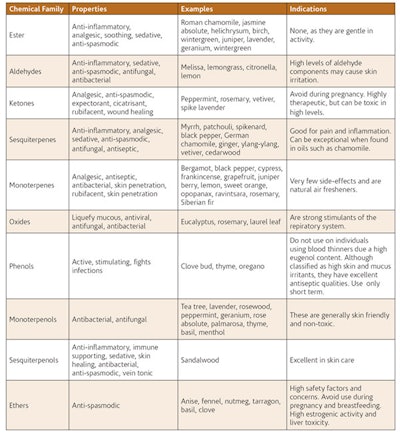
The healing power of essential oils has been used throughout history in the practices of esthetics, cosmetology and massage therapy. Madame Marguerite Maury (1895–1968) established the first aromatherapy clinics in Switzerland, Great Britain and Paris. She was the recipient of the Prix International Award for her work in natural skin care among other international awards involving the use of aromatherapy in the cosmetology setting.1
The unique footprint and therapeutic action of each essential oil is governed by components and complexities of aromatic chemistry.
Perhaps the most prodigious contributions made by Maury involved application of essential oils on the skin, the integration of essential oils in massage therapy and the science that binds the physiological, psychological and emotional aspects of essential oils. Aromatherapists René-Maurice Gattefossé and Jean Valnet, MD, established the scientific connection between healing and essential oils, and their work has since served as the foundation for aromatic chemistry and related sciences throughout history.2 (See Clinical Therapy Timeline.)
It is generally understood that the selection of an essential oil is popularly based on olfaction (scent). However, it is the therapeutic properties provided by these precious oils that invariably remains an enigma to many. The unique footprint and therapeutic action of each essential oil is governed by components and complexities of aromatic chemistry.
Essential oil characteristics
The synergistic relationship between essential oils and their therapeutic activity on the human body cannot be duplicated anywhere but in nature, but this relationship can be explained, in part, by looking at the plants from which they are derived. Plants are comprised of carbon, hydrogen and oxygen, making them compatible with human biochemistry.
In addition, they all have a similar protein and lipid matrix structure. Plants are able to transport valuable nutrients, and they are able to eliminate pathogens and cell debris through phagocytosis and membrane waste transport. All of these plant elements enable their essential oils to benefit the human body. Essential oils exhibit the following characteristics:
- Fragrance (olfaction), the volatility and purity of scent;
- Frequency (vibration), resonation and life force of
the oil; - Healing mechanisms (antiseptic, anti-viral, anti-spasmodic, anti-fungal, etc.);
- Transdermal absorption; and
- Physiological and psychological properties.
Essential oils contain hundreds and even thousands of natural chemical constituents that are metabolites from various plant materials.3 The average essential oil may contain 80–400 known chemical constituents.4
Each essential oil contains varying amounts of chemotypes that identify the specific activity or attribute of any given essential oil. These unique footprints are responsible for the oil’s identifiable fragrance and therapeutic characteristics. Due to their chemical complexity, essentials oils help maintain body homeostasis rather than disrupting it, as in the case with synthetic chemicals that have a primary focus or action.
A single essential oil may possess several actions on the body, mind and psyche, singularly or in tandem with other essential oils. The basis of applying essential oils for a desired therapeutic benefit requires knowing the monologue of the specific oil, and its chemotype attributes or activities.
The therapist may then select an essential oil with confidence from a scientific standpoint, and understand the chemical nature of the oil as it is applied, inhaled, massaged, blended or placed as a poultice. (See Primary Functional Groups of Essential Oils by Chemical Family.)
Identifying pure essential oils
With regard to quality, it is without question that only essential oils with high standards should be employed in the cosmetology or therapeutic setting. Inferior oils may be adulterated in several ways that are not visible or detectable unless diagnostic testing such as gas chromatography or viable results are presented at the time of procurement.
Adulteration may include the dilution of the oil with a similar component of inferior quality, the addition of a carrier oil, or the addition of an aromatic component that mimics or is similar in scent to the original monograph. None of these characteristics are desirable in the anticipation of a pure and therapeutic effect.
Selection of a high-grade essential oil involves:
- a reputable supplier or vendor; a monologue selection (benefits, activities, contraindications and bio-compatible oils);
- identification of chemical constituents and biochemical activity;
- distinction and identification of botanical genus and country of origin;
- identification of cultivation practices and methods used to obtain the oil;
- knowledge of distillation practices, methods, equipment and packaging; identification of quality designation, such as certified organic or certified pure therapeutic; and
- an evaluation of quality, such as gas chromatography/mass spectrometry (GC/MS).
As briefly mentioned before, gas chromatography (GC) is a laboratory method that separates the volatile compounds in essential oils into individual components. In this method, an instrument known as a gas chromatograph produces a graph that charts individual components contained in the essential oil.
Mass spectrometry (MS) identifies each of these components and their percentages. This process may also indicate that the essential oil has been adulterated in any way, or if the oil is of sub optimum quality. All the main components and some of the trace components will be listed on these reports.5
Essential oil chemistry
Some, but not all plants are able to generate chemotypes, identical plant forms with varying chemical makeup. It is important to understand the basic chemotype classifications, as these can dictate the therapeutic effects of a specific essential oil.
Hydrocarbons. Terpenes are a type of hydrocarbon that help to discharge existing toxins from the liver and kidneys, and inhibit the accumulation of toxins.
Sesquiterpenes. Similarly, sesquiterpenes are antiseptic and anti-inflammatory. They improve cellular memory and are present in almost all essential oils.
Oxygenated compounds. Esters (esterification) are compounds resulting from the reaction of an alcohol with an acid. Esters are common and are found in a large number of essential oils. They are anti-fungal, and have calming and relaxing effects.
Aldehydes. Aldehydes are highly reactive and anti-infectious, with a sedative effect on the central nervous system. They may cause irritation or dermatitis when applied topically; however, they induce a calming effect when inhaled.
Ketones. Ketones encourage cellular regeneration, promote the formation of tissue and liquify mucous. They are largely found in oils used for the upper respiratory system, such as hyssop, clary sage and sage.
Alcohols. Alcohols are commonly recognized for their antiseptic and anti-viral activities. They create an uplifting quality and are regarded as non-toxic.
Phenols.Phenols are the components that govern the fragrance blueprint of an oil. They are antiseptic, antibacterial, and stimulating; however, they may cause skin sensitivity if used undiluted. They contain high levels of oxygenating molecules and have exceptional antioxidant properties.
Oxides. Oxides are compounds that contain an element or radical and oxygen.6
Essential oils in practice
Essential oils are useful in the treatment of a variety of health issues, and can be used by the esthetician to address a number of skin concerns. However, before the esthetician embarks upon such a practice, they must first understand the history, chemistry, composition and evaluation of essential oils.
REFERENCES
- C Schiller and D Schiller, The Aromatherapy Encyclopedia: A Concise Guide to Over 385 Plant Oils, Basic Health Publication Inc.: Laguna Beach, CA, USA (2008)
- A Butje, E Repede and M Shattell, Healing Scents: An overview of clinical aromatherapy for emotional distress, Journal of Psychosocial Nursing and Mental Health Services, 46(10) 46–52 (2008)
- Aromatherapy and Essential Oils (PDQ), National Cancer Institute: Bethesda, MD, USA (Dec 30, 2014
- D Stewart, Chemistry of Essential Oils Made Simple: God’s Love Manifest In Molecules, N A P S A C Reproductions (Apr 25, 2005)
- L Fulcher, Are Your Essential Oils GC/MS Tested?, Aromatic Wisdom Institute (July 23, 2012) aromaticwisdominstitute.com/are-your-essential-oils-gcms-tested/
- Aromatherapy and the Chemistry of Essential Oils, Health Shoppe, www.therapeutic-grade.com/refs/chemistry.html
- J Valnet, The Practice of Aromatherapy: A Classic Compendium of Plant Medicines & Their Healing Properties, Healing Arts Press, Rochester, NY, USA (1990)
- J Thomason, Colds & Flu, American Council of Animal Nauturopathy, www.animalnaturopathy.org/colds-flu/
- JLW Robins, The Science and Art of Aromatherapy, J Holist Nurs March 17(1) 5–17 (1999)
- R d’Angelo, Aromatherapy, ch 4 in Handbook of complementary and alternative therapies in mental health, S. Shannon, ed, 71–92 Academic Press: San Diego, CA, USA
- R Tisserand, The oxygenation myth (Nov 10, 2010) roberttisserand.com/2010/11/the-oxygenation-myth/












